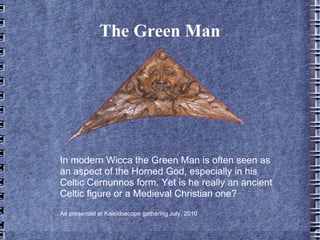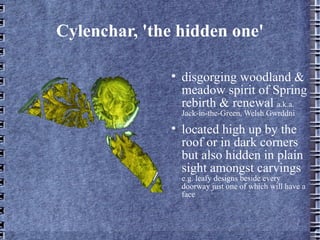The Green Man
- 1. The Green Man In modern Wicca the Green Man is often seen as an aspect of the Horned God, especially in his Celtic Cernunnos form. Yet is he really an ancient Celtic figure or a Medieval Christian one? As presented at Kaleidoscope gathering July, 2010
- 2. What We'll Cover (Agenda) ? What a Green Man is ? A brief review of the historical record ? What we think he may have represented to those who carved him ? A look at the Mysteries of Dying and Rebirth The Whitefield Green Man
- 3. Things to Remember ? We know almost nothing about the Green Man ? Now a central figure in Mayday lore & celebrations throughout North and Central Europe (from 18th C.) ? Pagans use him as an emblem of life, death and rebirth
- 4. Who is He? ? Frequently found in church architecture; also in municipal buildings ? Term dates from articles written in the 30's "The Green Man in Church Architecture", The Folklore Journal, 1939 ®C Lady Raglan ? No idea what, if any, name originally given ? a.k.a. Robin Hood, King of May, the Garland & Jack-in-the-Green ? central figure in N. & Central European Mayday celebrations
- 5. Types of Green Man ? Foliate (the head turning into leaves) ? Spewing, Uttering or Disgorging (spews vegetation from its mouth) ? (Blood)Sucker (branches coming from eyes, ears & nose) ? Jack In The Green (face appearing in a bower of leaves)
- 6. Earliest Records ? c.100 Viridios, Ancaster 2 inscriptions - (Proto-Celtic Wirdjos - 'Green Man'?) ? c.500 Nicetius decorates cathedral w. Green Man from a Roman temple ? Others follow suit ? Reformation: not seen ? Now been seen as a hidden decoration mostly in churches & cathedrals
- 7. Cylenchar, 'the hidden one' ? disgorging woodland & meadow spirit of Spring rebirth & renewal a.k.a. Jack-in-the-Green, Welsh Gwrddni ? located high up by the roof or in dark corners but also hidden in plain sight amongst carvings e.g. leafy designs beside every doorway just one of which will have a face
- 8. What Might He Represent? ? Resurrection - hope of new life, green leaves sprouting from a sometimes obviously dead head ? Creation - uttering leaves into being ? Wood Spirits - leaf masks in particular seem to show beneficent face shining with energy of Nature ? Protection - if Celtic, its use beside or above doors may protect the building from evil spirits or luck ? Fertility - some, especially cat-like ones, seem to be associated with harvest (cat as corn spirit)
- 9. (continued) ? Portraiture - some have such character it appears to be taken from life. Are these portraits of clerics, sponsors, masons etc. involved with the building? ? Decoration - Renaissance foliate heads merely a formal decoration & found everywhere ? Wealth - 19th C. Banks frequently feature Green Men. Not only is such carving the preserve of the wealthy, but the lush foliage issuing from a face symbolises the generation of wealth at that time.
- 10. Gawain & the Green Knight, ? The story-poem of Gawain and the Green Knight was written in the 14th century°™a time when many of the foliate heads were being carved on the cathedrals of Europe. ? http://www.authorsden.com/visit/viewArticle.asp?id=13535
- 11. Rosslyn Chapel ? excess of 110 carvings of Green men in and around the Chapel ? progress from E. to W. young in East (Spring) aging as we progress towards the setting sun in the West & Autumn of man's years
- 12. How We Use Him ? As an archetype of our oneness with the earth hence as a symbol of the Green movement ? Son of the God of life & death and of the Goddess of birth & renewal ? Some Wiccans see him as the Ever Returning One as opposed to the Horned Lord of death and what comes after
- 13. Q&A













